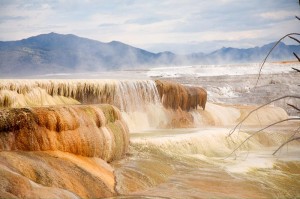If you are considering a home improvement project that involves floors or tiles, consider using travertine tiles. Travertine is formed by the precipitation of carbonate minerals from ground, surface, or geothermally heated spring waters. This occurs where the water comes in close proximity with magma at some depth. While the water circulates and heats, it picks up dissolved minerals and solids. Those minerals are re-deposited when the water cools.
Typically, the crystallized minerals are calcium-based, or calcareous. The different impurities within the deposit contributes to the color and pattern of the stone. The random distribution of the colors gives each stone a unique design, which is one of the main appeals of this material.
In the United States, one of the best known areas where travertine is prevalent is in the Yellow Stone Basin in the National Park. There, geysors like Old Faithful circulate water in subterranian networks where it is heated. In the case of geysors, the water reaches a temperature where the steam pressure overcomes the overlaying water and it erupts in a dramatic display of steam and hot water. In other places, like Mammoth Hot Springs, the warm water comes to the surface less violently, but builds up deposits of travertine layer upon layer.

Mammoth Hot Springs at Yellowstone National Park where travertine is deposited from the geothermal waters.
Decorative stones are cut from source blocks in the quarry (not, of course, in the national park), and then taken for further processing. Based upon the intended use of the stones, they are cut and sized accordingly. Since the stone was originally deposited in a water environment there are usually many holes and pits. Frequently, these holes are filled with epoxy, cement, and dyes, but it can be used in its natural state if an uneven surface is no problem. The stone can also be honed or polished.
There are two or three small travertine quarries in the western United States. These quarries have a low production and the quality of stone is usually considered poor. A decade ago Italy had a near monopoly on the travertine market. Today Italy is still a leader, but has been joined by many other countries like Turkey, Mexico, and Peru.
Travertine has been used many ways. It can be used in a walkway, driveway, lanais, floor and wall covering, patio, and fountain. It can be used indoors and out. It has a wide variety of finishes and the price can be less than ceramic tile and wood flooring. When installed properly travertine will last the lifetime of a house.
Related Posts:
Advice on Installing Travertine Tiles
Unusual Occurrence of a Fossil in Travertine